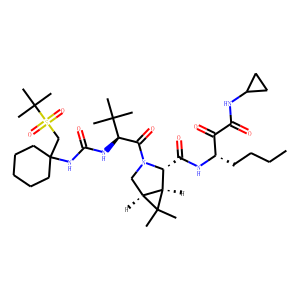| Reference | 1. J Viral Hepat. 2013 Nov;20(11):779-89. doi: 10.1111/jvh.12104. Epub 2013 Jun 27.
<br>
Evolutionary dynamics of hepatitis C virus NS3 protease domain during and
following treatment with narlaprevir, a potent NS3 protease inhibitor.
<br>
de Bruijne J(1), Thomas XV, Rebers SP, Weegink CJ, Treitel MA, Hughes E, Bergmann
JF, de Knegt RJ, Janssen HL, Reesink HW, Molenkamp R, Schinkel J.
<br>
Author information: <br>
(1)Department of Gastroenterology and Hepatology, Academic Medical Center,
Amsterdam, The Netherlands.
<br>
Narlaprevir, a hepatitis C virus (HCV) NS3/4A serine protease inhibitor, has
demonstrated robust antiviral activity in a placebo-controlled phase 1 study. To
study evolutionary dynamics of resistant variants, the NS3 protease sequence was
clonally analysed in thirty-two HCV genotype 1-infected patients following
treatment with narlaprevir. Narlaprevir monotherapy was administered for one week
(period 1) followed by narlaprevir/pegylated interferon-alpha-2b combination
therapy with or without ritonavir (period 2) during two weeks, interrupted by a
washout period of one month. Thereafter, all patients initiated pegylated
interferon-alpha-2b/ribavirin combination therapy. Longitudinal clonal analysis
was performed in those patients with NS3 mutations. After narlaprevir
re-exposure, resistance-associated mutations at position V36, T54, R155 and A156
were detected in five patients in >95% of the clones. Narlaprevir retreatment
resulted in a 2.58 and 5.06 log10 IU/mL viral load decline in patients with and
without mutations, respectively (P=<0.01). After treatment, resistant variants
were replaced with wild-type virus within 2-24 weeks in three patients. However,
the R155K mutation was still observed 3.1 years after narlaprevir dosing in two
patients in 5% and 45% of the viral population. Resistant variants could be
detected early during treatment with narlaprevir. A slower viral load decline was
observed in those patients with resistance-associated mutations detectable by
direct population sequencing. These mutations disappeared within six months
following treatment with the exception of R155K mutation, which persisted in two
patients.
<br>
2. Antimicrob Agents Chemother. 2010 Jun;54(6):2365-70. doi: 10.1128/AAC.00135-10.
Epub 2010 Mar 22.
<br>
Preclinical characterization of the antiviral activity of SCH 900518
(narlaprevir), a novel mechanism-based inhibitor of hepatitis C virus NS3
protease.
<br>
Tong X(1), Arasappan A, Bennett F, Chase R, Feld B, Guo Z, Hart A, Madison V,
Malcolm B, Pichardo J, Prongay A, Ralston R, Skelton A, Xia E, Zhang R, Njoroge
FG.
<br>
Author information: <br>
(1)Department of Virology, Schering-Plough Research Institute, Kenilworth, NJ
07033, USA. [email protected]
<br>
Small-molecule hepatitis C virus (HCV) NS3 protease inhibitors such as boceprevir
(SCH 503034) have been shown to have antiviral activity when they are used as
monotherapy and in combination with pegylated alpha interferon and ribavirin in
clinical trials. Improvements in inhibitor potency and pharmacokinetic properties
offer opportunities to increase drug exposure and to further increase the
sustained virological response. Exploration of the structure-activity
relationships of ketoamide inhibitors related to boceprevir has led to the
discovery of SCH 900518, a novel ketoamide protease inhibitor which forms a
reversible covalent bond with the active-site serine. It has an overall
inhibition constant (K*(i)) of 7 nM and a dissociation half-life of 1 to 2 h. SCH
900518 inhibited replicon RNA at a 90% effective concentration (EC(90)) of 40 nM.
In biochemical assays, SCH 900518 was active against proteases of genotypes 1 to
3. A 2-week treatment with 5x EC(90) of the inhibitor reduced the replicon RNA
level by 3 log units. Selection of replicon cells with SCH 900518 resulted in the
outgrowth of several resistant mutants (with the T54A/S and A156S/T/V mutations).
Cross-resistance studies demonstrated that the majority of mutations for
resistance to boceprevir and telaprevir caused similar fold losses of activity
against all three inhibitors; however, SCH 900518 retained more activity against
these mutants due to its higher intrinsic potency. Combination treatment with
alpha interferon enhanced the inhibition of replicon RNA and suppressed the
emergence of resistant replicon colonies, supporting the use of SCH
900518-pegylated alpha interferon combination therapy in the clinic. In summary,
the results of the preclinical characterization of the antiviral activity of SCH
900518 support its evaluation in clinical studies.
<br>
3. ACS Med Chem Lett. 2010 Feb 15;1(2):64-9. doi: 10.1021/ml9000276. eCollection
2010 May 13.
<br>
Discovery of Narlaprevir (SCH 900518): A Potent, Second Generation HCV NS3 Serine
Protease Inhibitor.
<br>
Arasappan A(1), Bennett F(1), Bogen SL(1), Venkatraman S(1), Blackman M(1), Chen
KX(1), Hendrata S(1), Huang Y(1), Huelgas RM(1), Nair L(1), Padilla AI(1), Pan
W(1), Pike R(1), Pinto P(1), Ruan S(1), Sannigrahi M(1), Velazquez F(1),
Vibulbhan B(1), Wu W(1), Yang W(1), Saksena AK(1), Girijavallabhan V(1), Shih
NY(1), Kong J(1), Meng T(1), Jin Y(1), Wong J(1), McNamara P(1), Prongay A(1),
Madison V(1), Piwinski JJ(1), Cheng KC(1), Morrison R(1), Malcolm B(1), Tong
X(1), Ralston R(1), Njoroge FG(1).
<br>
Author information: <br>
(1)Schering Plough Research Institute, 2015 Galloping Hill Road, Kenilworth, New
Jersey 07033.
<br>
Boceprevir (SCH 503034), 1, a novel HCV NS3 serine protease inhibitor discovered
in our laboratories, is currently undergoing phase III clinical trials. Detailed
investigations toward a second generation protease inhibitor culminated in the
discovery of narlaprevir (SCH 900518), 37, with improved potency (~10-fold over
1), pharmacokinetic profile and physicochemical characteristics, currently in
phase II human trials. Exploration of synthetic sequence for preparation of 37
resulted in a route that required no silica gel purification for the entire
synthesis.
<br>
|

